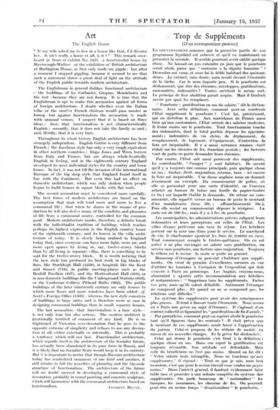Art
The English Home
" IF my wife asked me to live in a house like that,. I'd divorce her. It isn't really a home at all, is it ? " This remark over- heard in front of exhibit No. 1231 —a functionalist house by -Myerscough-Walker—at the exhibition of British architecture at Burlington House, at first only made me giggle ; but after .a moment I stopped giggling, because it seemed to me that such a statement threw a great deal of light on the attitude of the English public towards modern architecture.
The Englishman in general dislikes functional architecture —the buildings of Le Corbusier, Gropius, Mendelsohn and -the rest—because they are not homey. It is true that the 'Englishman is apt to make this accusation against all forms of foreign architecture—I doubt whether even the Italian -villa- or the smal'er French chateau would pass muster as homey—but against functionalism the accusation is made with unusual venom. I suspect that it is based on thrjee ideas : first, that functionalism is not characteristically English ; secondly, that it does not take the family as unit ; and, thirdly, that it is very bare.
Throughout its whole history English architecture has been strangely independent. English Gothic is very different from French ; the Jacobean style has only a very rough equivalent in other northern countries ; Inigo Jones and Wren borrow from Italy and France, but are always whole-heartedly English in feeling, and in the eighteenth century England developed its most individual styles for the country and town house. In fact, it was not till the invasion of the international Baroque of the big shop style that England found itself in line with the Continent. But even this had no effect on domestic architecture, which was only shaken when people began to build houses in square blocks with flat roofs.
The second accusation must be considered more carefully. The best forms of modern architecture are based on the assumption that man will tend more and more to live a communal life ; that when he shares in the means of pro- duction he will also derive many of the comforts and pleasures of life from a communal source, controlled for the common good. Modern architecture marks, therefore, a definite break with the individualist tradition of building, which reaches perhaps its highest expression in the English country house of the eighteenth century, and its lowest in the villa archi- tecture of today. It is slowly being realised in England today that, since everyone can have more light, more air, and more open spaces by living in, say, twelve-storey blocks than by all living in separate villas, there is something to be said for the twelve-storey block. It is worth noticing that the new style has produced its best work in big blocks of flats, like Stockteigh Hall (1238), in hospitals like the Kent and Sussex (718), in public meeting-places such as the Bexhill Pavilion (427), and the Horticultural Hall (418), or in non-domestic buildings like the Underground Stations (653), or the Cardowan Colliery Pithead Baths (692). The public buildings of the later nineteenth century arc only houses to which more floors and more windows have been added—cf. Scott's Foreign Office (1503)—whereas the new style conceives of buildings in large units, and is therefore more at ease in designing communal buildings than in small, separate houses.
The last accusation—that functionalism is a bare style— Ls not only true but also serious. The modern architect is irrationally terrified of ornament of any kind. He is so frightened of Victorian over-decoration that he goes to the opposite extreme of simplicity and refuses to use any decora- tion at all, either externally or internally. This is probably a tendency which will not last. Functionalist architecture, which regards itself as the architecture of the Socialist future, has actually been abandoned in its pure form in Russia, and it is likely that no Socialist State would keep it in its entirety. But it is important to notice that though Russian architecture today has readmitted ornament of one kind and another, it still retains in full the novelties of planning and the big-scale structure of functionalism. The architecture of the future will no doubt succeed in developing a communal style of decoration, probably in mural painting and concrete sculpture, which will harmonise with the communal architecture based on










































 Previous page
Previous page